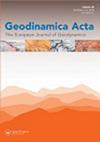Geochemical constraints on provenance and source area weathering of metasedimentary rocks from the Paleoproterozoic (~2.1 Ga) Wa-Lawra Belt, southeastern margin of the West African Craton
IF 1.5
Q1 Earth and Planetary Sciences
引用次数: 23
Abstract
ABSTRACT The Wa-Lawra Belt which is situated in the northern part of Ghana consists of Paleoproterozoic Birimian fine metasedimentary rocks metamorphosed to greenschist facies, particularly, in the western part. A whole-rock geochemical study of these metasedimentary rocks was undertaken to unravel their source area weathering, provenance and tectonic setting. Geochemical characteristics of the studied shales show that they are immature in nature and first cycle in origin, with little or no recycled component. Compared to Post-Archaean Australian Shales (PAAS), the studied shales indicate reduction in Zr, Hf, La, Nb, Th and Ta being the high field strength elements and evidences of transition metal enrichments in V, Ni, Sc, Co, and Cr. Major element geochemistry indicates that the shales were subjected to slight potassium metasomatism after deposition. Pre-metasomatized Chemical Index of Alteration calculations indicates that weak to moderate degree of chemical weathering took place at the sediment source area. Co-Th-La-Sc systematics reveals a combination of mafic and felsic provenances for the shales. Eu/Eu* together with values of Th/U and some abundances of trace elements show that the shales were mainly derived from juvenile rocks. Average REE model calculations suggest that the source materials are composed of about 49% basalt, 16% TTG and 35% granite.西非克拉通东南缘古元古代(~2.1 Ga) Wa-Lawra带变质沉积岩物源及源区风化的地球化学约束
加纳北部的Wa-Lawra带由古元古代Birimian细变质变质为绿片岩相的变质沉积岩组成,特别是在其西部。对这些变质沉积岩进行了全岩地球化学研究,揭示了它们的源区、风化、物源和构造背景。研究页岩的地球化学特征表明,其性质不成熟,为第一旋回成因,很少或不含再循环成分。与后太古代澳大利亚页岩(PAAS)相比,研究区页岩中Zr、Hf、La、Nb、Th、Ta为强场强元素减少,V、Ni、Sc、Co、Cr等过渡金属富集,主元素地球化学特征表明,沉积后页岩发生了轻微的钾交代作用。预交代化学蚀变指数计算表明,沉积物源区发生了弱至中等程度的化学风化作用。Co-Th-La-Sc系统揭示了页岩的基性和长英质混合物源。Eu/Eu*、Th/U值及部分微量元素丰度表明页岩主要来源于幼岩。平均稀土元素模型计算表明,玄武岩占49%,TTG占16%,花岗岩占35%。
本文章由计算机程序翻译,如有差异,请以英文原文为准。
求助全文
约1分钟内获得全文
求助全文
来源期刊

Geodinamica Acta
地学-地球科学综合
CiteScore
4.50
自引率
0.00%
发文量
0
审稿时长
25 weeks
期刊介绍:
Geodinamica Acta provides an international and interdisciplinary forum for the publication of results of recent research dealing with both internal and external geodynamics. Its aims to promote discussion between the various disciplines that work on the dynamics of the lithosphere and hydrosphere. There are no constraints over themes, provided the main thrust of the paper relates to Earth''s internal and external geodynamics. The Journal encourages the submission of papers in all fields of earth sciences, such as biostratigraphy, geochemistry, geochronology and thermochronology, geohazards and their societal impacts, geomorphology, geophysics, glaciology, igneous and metamorphic petrology, magmatism, marine geology, metamorphism, mineral-deposits and energy resources, mineralogy, orogeny, palaeoclimatology, palaeoecology, paleoceanograpgy, palaeontology, petroleum geology, sedimentology, seismology and earthquakes, stratigraphy, structural geology, surface processes, tectonics (neoteoctonic, plate tectonics, seismo-tectonics, Active tectonics) and volcanism.
Geodinamica Acta publishes high quality, peer-reviewed original and timely scientific papers, comprehensive review articles on hot topics of current interest, rapid communications relating to a significant advance in the earth sciences with broad interest, and discussions of papers that have already appeared in recent issues of the journal. Book reviews are also included. Submitted papers must have international appeal and regional implications; they should present work that would be of interest to many different specialists. Geographic coverage is global and work on any part of the world is considered. The Journal also publishes thematic sets of papers on topical aspects of earth sciences or special issues of selected papers from conferences.
 求助内容:
求助内容: 应助结果提醒方式:
应助结果提醒方式:


